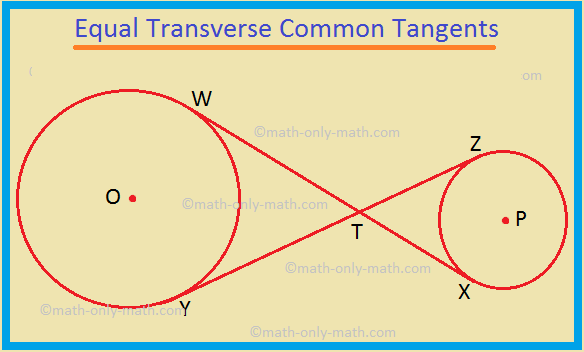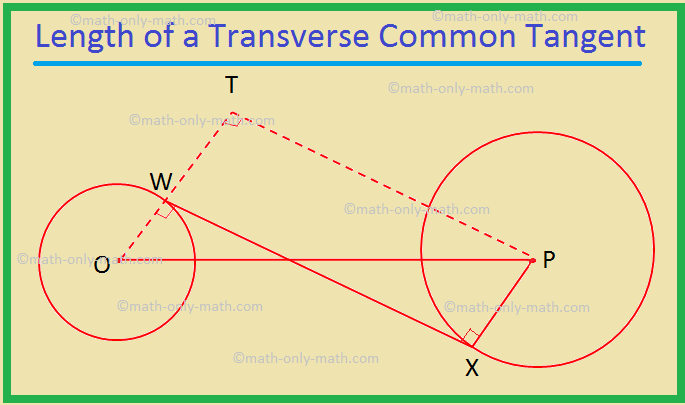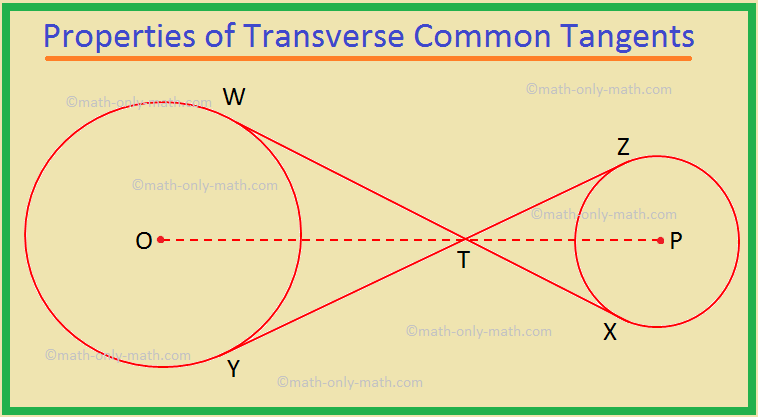Subscribe to our ▶️ YouTube channel 🔴 for the latest videos, updates, and tips.
Important Properties of Transverse Common Tangents
I. The two transverse common tangents drawn to two circles are equal in length.
Given:
WX and YZ are two transverse common tangents drawn to the two given circles with centres O and P. WX and YZ intersect at T.
To prove: WX = YZ.
Proof:
|
Statement |
Reason |
|
1. WT = YT. |
1. The two tangents, drawn to a circle from an external point, are equal in length. |
|
2. XT = ZT. |
2. An in statement 1. |
|
3. WT + XT = YT + ZT ⟹ WX = YZ. (Proved) |
3. Adding statements 1 and 2. |
II. The length of a transverse common tangent to two circles is \(\sqrt{d^{2} – (r_{1} + r_{2})^{2}}\), where d is the distance between the centres of the circles, and r\(_{1}\) and r\(_{2}\) are the radii of the given circles.
Proof:
Let two circles be given with centres O and P, and radii r\(_{1}\) and r\(_{2}\) respectively, where r\(_{1}\) < r\(_{2}\). Let the distance between the centres of the circles, OP = d.
Let WX be a transverse common tangent.
Therefore, OW = r\(_{1}\) and PX = r\(_{2}\).
Also, OW ⊥ WX and PX ⊥ WX, because a tangent is perpendicular to the radius drawn through the point of contact
Produce W to T such that WT = PX = r\(_{2}\). Join T to P. In the quadrilateral WXPT, WT ∥ PX, as both are perpendiculars to WX; and WT = PX. Therefore, WXPT is a rectangle. Thus, WX = PT, as the opposite sides of a rectangle are equal.
OT = OW + WT = r\(_{1}\) + r\(_{2}\).
In the right-angled triangle OPT, we have
PT2 = OP2 – OT2 (by Pythagoras’ Theorem)
⟹ PT2 = d2 – (r\(_{1}\) + r\(_{1}\))\(^{2}\)
⟹ PT = \(\sqrt{d^{2} – (r_{1} + r_{2})^{2}}\)
⟹ WX = \(\sqrt{d^{2} – (r_{1} + r_{2})^{2}}\) (Since, PT = WX).
III. The transverse common tangents drawn to two circles intersect on the line drawn through the centres of the circles.
Given: Two circles with centres O and P, and their transverse common tangents WX and YZ, which intersects at T
To prove: T lies on the line joining O to P, i.e., O T and P lie on the same straight line.
Proof:
|
Statement |
Reason |
|
1. OT bisects ∠WTY ⟹ ∠ATO = \(\frac{1}{2}\)∠WTY. |
1. The tangents drawn to a circle from an external point are equally inclined to the line joining the point to the centre of the circle. |
|
2. TP bisects ∠ZTX ⟹ ∠XTP = \(\frac{1}{2}\)∠ZTX. |
2. As in statement 1. |
|
3. ∠WTY = ∠ZTX. |
3. Vertically opposite angles. |
|
4. ∠WTO = ∠XTP. |
4. From statement 1, 2 and 3. |
|
5. OT and TP lie on the same straight line ⟹ O, T, P are collinear. (Prove) |
5. The two angles are forming a pair of vertically opposite angles. |
From Important Properties of Transverse Common Tangents to HOME PAGE
Didn't find what you were looking for? Or want to know more information about Math Only Math. Use this Google Search to find what you need.





New! Comments
Have your say about what you just read! Leave me a comment in the box below. Ask a Question or Answer a Question.